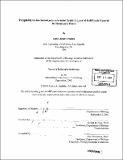| dc.contributor.advisor | Gerald R. Fink. | en_US |
| dc.contributor.author | Andalis, Alexis Albert, 1973- | en_US |
| dc.contributor.other | Massachusetts Institute of Technology. Dept. of Biology. | en_US |
| dc.date.accessioned | 2006-03-24T16:25:04Z | |
| dc.date.available | 2006-03-24T16:25:04Z | |
| dc.date.copyright | 2003 | en_US |
| dc.date.issued | 2003 | en_US |
| dc.identifier.uri | http://hdl.handle.net/1721.1/29783 | |
| dc.description | Thesis (Ph. D.)--Massachusetts Institute of Technology, Dept. of Biology, 2003. | en_US |
| dc.description | Includes bibliographical references. | en_US |
| dc.description.abstract | Advances in genome sequencing and comparative genomics have uncovered ancient duplications in the genomes of many extant organisms. Evidence for large regional duplications is observed in eukaryotic organisms that include yeast, plants, fish, and humans. Furthermore, phylogenetic analysis of paralogous duplications within these organisms provides support for a single duplication event of the entire genome. The prevalence of genomic duplications lends credence to proposals that suggest that evolution is driven by polyploidization. This evidence must be balanced by recent experiments that demonstrate that newly formed polyploid genomes manifest problems in genomic stability, gene regulation, and development. In order to determine the consequences of nascent duplications of the entire genome, I created isogenic polyploid strains in Saccharomyces cerevisiae. These newly formed polyploids do not grow abnormally during exponential growth. Furthermore, they are not increased or decreased in their sensitivity to a variety of stresses including oxidative stress, high osmolarity, salt stress, toxic ions, and growth at high temperatures. However, polyploid strains of S. cerevisiae rapidly lose viability under conditions of nutrient deprivation. In contrast to isogenic haploids that remain viable for weeks and even months, tetraploid yeast are completely inviable after approximately 10-15 days in synthetic media. Analysis of the growth patterns of haploid and tetraploid cells during stationary phase reveals that tetraploids are defective for growth arrest during nutrient deprivation. | en_US |
| dc.description.abstract | (cont.) Furthermore, alterations that impede their inappropriate mitotic growth, such as deletion of the G1 cyclin, CLN3, can restore viability in tetraploids during stationary phase. The stationary phase defects found in tetraploid cells are notably similar to those observed in haploid cells that constitutively activate the glucose sensing Ras/cAMP pathway. In addition, all of these defects are suppressed by overexpression of the Ras/cAMP pathway inhibitor, RPII. Although these data suggest a role for RPIH in the restoration of tetraploid viability, the precise function remains elusive. Nevertheless, RPI1 may define a compensatory change that permits the survival of nascent polyploid organisms. | en_US |
| dc.description.statementofresponsibility | by Alexis Albert Andalis. | en_US |
| dc.format.extent | 304 leaves | en_US |
| dc.format.extent | 9653463 bytes | |
| dc.format.extent | 9653263 bytes | |
| dc.format.mimetype | application/pdf | |
| dc.format.mimetype | application/pdf | |
| dc.language.iso | eng | en_US |
| dc.publisher | Massachusetts Institute of Technology | en_US |
| dc.rights | M.I.T. theses are protected by copyright. They may be viewed from this source for any purpose, but reproduction or distribution in any format is prohibited without written permission. See provided URL for inquiries about permission. | en_US |
| dc.rights.uri | http://dspace.mit.edu/handle/1721.1/7582 | |
| dc.subject | Biology. | en_US |
| dc.title | Polyploidy in Saccharomyces cerevisiae leads to the loss of cell cycle control in stationary phase | en_US |
| dc.title.alternative | Polyploidy in S. cerevisiae leads to the loss of cell cycle control in stationary phase | en_US |
| dc.type | Thesis | en_US |
| dc.description.degree | Ph.D. | en_US |
| dc.contributor.department | Massachusetts Institute of Technology. Department of Biology | |
| dc.identifier.oclc | 54808418 | en_US |
